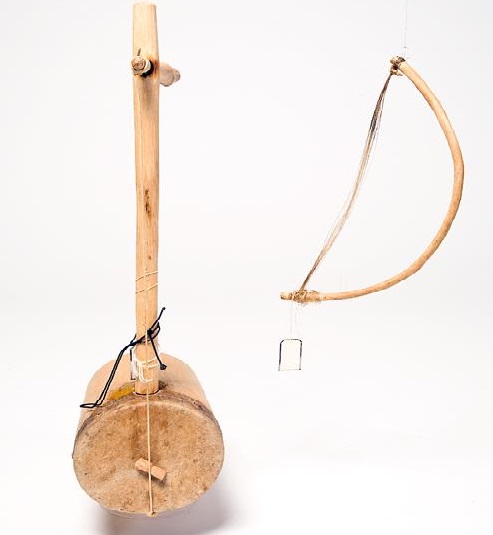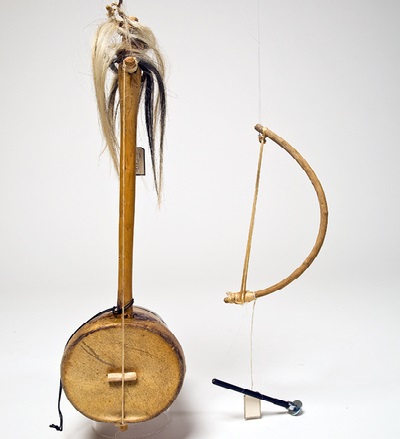Endingidi
Bowed Instruments
Africa
Unknown
Video
The Endingidi is a traditional musical instrument from Uganda that holds a significant place in the country’s rich musical heritage. Known for its unique design and captivating sound, the Endingidi has been an integral part of Ugandan culture for centuries. Its deep connection to both the musical and social life of the communities that use it makes it a fascinating subject of study for those interested in the diverse musical traditions of Africa.
History and Origin of the Endingidi
The Endingidi is a stringed instrument that has deep roots in the traditional music of Uganda, particularly among the Baganda people. It is a member of the bow-harp family, a group of instruments found throughout many parts of Africa, characterized by their use of a bow to produce sound from a set of strings. The origins of the Endingidi can be traced back to ancient times, although precise details regarding its exact date of creation are somewhat unclear.
The exact year of the origin of the endingidi is not well documented, but it is believed to have been in use for centuries, likely since the 15th or 16th centuries, coinciding with the establishment of the Buganda Kingdom (one of the largest kingdoms in Uganda). The endingidi is a traditional instrument used in royal courts, ceremonies, and social events among the Baganda people, and it holds cultural significance.
Historically, the Endingidi has been a popular instrument among the Baganda, one of Uganda’s largest ethnic groups. The instrument has been used in various social and cultural settings, such as royal courts, traditional ceremonies, and community gatherings. It has often been played during celebrations, rituals, and storytelling, where its rich, resonant sound would accompany dancers, singers, and performers. The instrument’s historical significance is tied to its ability to convey important messages and emotions. In many Ugandan cultures, music is not just for entertainment; it is used to communicate social and political messages, express emotions, and even impart wisdom. The Endingidi, with its haunting melodies and powerful resonance, has played a role in all of these functions. It is said to have been used by royal musicians to accompany the kings and chiefs of Uganda, further cementing its place in the country’s rich musical tradition.
Working Mechanism and Features of the Endingidi
The Endingidi is a traditional stringed instrument, but it operates differently from other Western string instruments like the violin or cello. Its unique construction and playing technique give it a distinct sound that is characteristic of Ugandan and Central African music.
Structure and Design
The Endingidi is typically made from locally sourced materials, including wood, gourds, and animal skin. The instrument has a hollow body that serves as the resonator, and its structure is relatively simple but carefully crafted for optimal sound production. The body of the Endingidi is traditionally made from a large gourd or a wooden box, both of which are carved to create a hollow chamber that amplifies the vibrations of the strings.
A wooden neck is attached to the body, with one end of the neck serving as the anchor for the strings. The strings of the Endingidi are usually made from animal gut or, in modern times, nylon or wire. There are typically three to five strings on the instrument, although the number of strings can vary depending on the specific version of the Endingidi being played. The bow used to play the Endingidi is made from a flexible piece of wood, typically with horsehair or synthetic material stretched across it. The bow is used to create friction against the strings, causing them to vibrate and produce sound. Unlike Western bowed string instruments, the Endingidi’s strings are relatively thick, which results in a deep, resonant tone.
The player holds the bow in one hand and uses the other hand to press down on the strings to vary the pitch. Unlike many string instruments that rely on finger placement on the fingerboard, the Endingidi player uses a sliding technique, moving the fingers along the strings to adjust the pitch as the bow is drawn across them. This sliding motion is a key feature of the instrument and contributes to its unique sound.
Sound Production
The sound produced by the Endingidi is rich and resonant, with a deep, soulful quality that resonates with the listener. The hollow body amplifies the vibrations of the strings, and the tension of the strings determines the pitch produced. By varying the tension of the strings using the bow and fingers, the player can create a wide range of pitches, from deep, low notes to higher, more melodic sounds.
The bowing technique used on the Endingidi is essential to its sound. The player moves the bow in a steady, rhythmic motion across the strings, producing a continuous tone. The player can also adjust the pressure and speed of the bow to create different dynamics and textures. The ability to vary the pressure of the bow allows the performer to create a wide array of expressive sounds, from soft, delicate tones to more forceful, powerful sounds.
In addition to the traditional bowing technique, the Endingidi can also be plucked, though this is less common. When plucked, the instrument produces a sharp, percussive sound that is sometimes used for rhythmic accompaniment in Ugandan music.
Playing Techniques
The Endingidi is played with a variety of techniques, but the most prominent is the sliding motion of the fingers along the strings. This sliding motion, often referred to as “glissando,” allows the player to seamlessly transition between pitches and create a smooth, flowing sound. The glissando technique is central to the musical expression of the Endingidi, allowing the performer to express a wide range of emotions, from sorrow to joy.
In addition to glissando, players may also use vibrato, a technique where the pitch of a note is subtly altered by shaking the finger on the string. This adds warmth and richness to the sound and is used to create emotional depth in the music.
The bow is typically held in the right hand, and the left hand is used to control the pitch by sliding along the strings. In some variations of the Endingidi, the player may also use the left hand to mute or dampen certain strings to create a muted, percussive effect. This can be especially effective in fast-paced, rhythmic music.
Types of Endingidi and Their Features
While the basic design of the Endingidi remains relatively consistent, there are different regional variations of the instrument within Uganda. These variations can differ in size, shape, the number of strings, and the playing technique used.
- The Baganda Endingidi: The Baganda people, one of Uganda’s largest ethnic groups, are known for their use of the Endingidi. The Baganda version of the instrument typically features a large gourd body and three to five strings made from animal gut. This variation of the Endingidi is often played during royal ceremonies, important celebrations, and storytelling events. The Baganda Endingidi is typically tuned to a pentatonic scale, allowing the player to create a wide range of melodic and harmonic possibilities. The instrument’s rich, resonant tones are often used to accompany singing, dancing, and other forms of performance art in traditional Baganda culture.
- The Banyoro and Bakiga Endingidi: In addition to the Baganda people, the Endingidi is also found among other ethnic groups in Uganda, such as the Banyoro and Bakiga. These variations may differ slightly in construction, particularly in the shape and size of the resonator and the number of strings. However, the basic principles of sound production and playing technique remain consistent. The Banyoro and Bakiga versions of the Endingidi are often used in community rituals and ceremonies. The music played on these instruments is highly expressive, and the performers often use the instrument to communicate stories, emotions, and messages to their audiences.
The Endingidi is a captivating and unique musical instrument that continues to be a symbol of Uganda’s rich cultural heritage. Its deep, resonant tones, coupled with its distinctive playing techniques, make it a remarkable example of traditional African craftsmanship. Whether used in royal courts, cultural ceremonies, or community events, the Endingidi remains a powerful vehicle for storytelling, expression, and communication.
As Uganda continues to celebrate its diverse musical traditions, the Endingidi stands as a testament to the enduring power of music to connect people, preserve culture, and inspire future generations. Its revival in modern times speaks to a growing appreciation for traditional instruments and a desire to preserve the musical legacies of African communities.
FAQ
What is the composition of the Endingidi musical instrument?
The Endingidi is a traditional Ugandan musical instrument made from wood, with a long, curved neck. The instrument features a resonating body, often made from hollowed-out wood, which amplifies the sound produced by its strings. It typically has four strings made from plant fibers, which are plucked or bowed to produce sound. The bow is often crafted from flexible wood and string, allowing for precise control of pitch and tone.
What are the key characteristics of the Endingidi?
The Endingidi is known for its distinctive, rich, and resonant sound. It has a long, curved neck that gives it a unique visual appeal, and the resonating body allows for a deep, rich tonal quality. The instrument is generally played by plucking or bowing its four strings, which results in a sound that can range from gentle to intense, depending on the player's technique. The Endingidi is known for its flexibility and expressive potential, making it a central part of Ugandan traditional music.
What kind of music is the Endingidi used for?
The Endingidi is used in various forms of Ugandan traditional music, including ceremonial, festive, and storytelling performances. It is often played during community events, such as weddings, initiation ceremonies, and religious festivals. The instrument is also a popular accompaniment in dance performances and is used in storytelling to add emotional depth. The sound of the Endingidi is especially suited for vocal performances, as it complements the human voice in many Ugandan musical traditions.
How is the Endingidi played?
The Endingidi is typically played with a bow, although it can also be plucked. To play the instrument, the musician holds the bow and moves it across the strings to create a sound. The pitch is altered by pressing the strings along the neck of the instrument. Skilled players can achieve a wide range of tones and dynamics, producing everything from soft, melodic lines to sharp, percussive sounds. The player can adjust the tension on the strings to create different tonal qualities, making it a versatile instrument for both rhythm and melody.
 Links
Links
References
Other Instrument
Categories



















